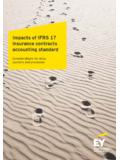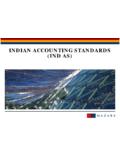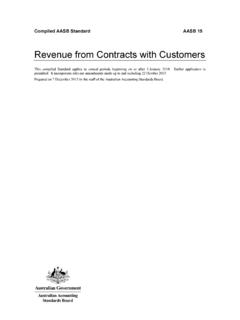Transcription of Standards/Interpretations Issued Not Yet Effective …
1 Standards/Interpretations Issued Not Yet Effective as at 7 February 2018. IAS 8 requires that when an entity has not applied a new Standard or interpretation that has been Issued but is not yet Effective , the entity shall disclose: (a) this fact; and (b) known or reasonably estimable information relevant to assessing the possible impact that application of the new Standard or interpretation will have on the entity's financial statements in the period of initial application. The standard requires you to consider the following in your disclosure: (a) the title of the new Standard or interpretation ;. (b) the nature of the impending change or changes in accounting policy.
2 (c) the date by which application of the Standard or interpretation is required;. (d) the date as at which it plans to apply the Standard or interpretation initially;. and (e) either: a discussion of the impact that initial application of the Standard or interpretation is expected to have on the entity's financial statements; or if that impact is not known or reasonably estimable, a statement to that effect. (f) for the current period and each prior period presented, to the extent practicable, the amount of the adjustment: for each financial statement line item affected; and if IAS 33 Earnings per Share applies to the entity, for basic and diluted earnings per share.
3 Below is a list of the current standards and interpretations that have been Issued , but may not be Effective . Please ensure your disclosure is updated. Brochure is for information purposes only. accepts no responsibility for reliance placed on it. For an official view on any issue, please contact us. Copyright Standard Details of amendment Annual periods beginning on or after IFRS 1, First-time Annual Improvements 2014-2016 Cycle: 1 January 2018. Adoption of Deletion of short-term exemptions that are no International Financial longer applicable. Reporting standards IFRS 2, Share-based Classification and Measurement of Share-based 1 January 2018.
4 Payment Payment Transactions: A collection of three distinct narrow-scope amendments dealing with classification and measurement of share-based payments. The amendments address: o the effects of vesting conditions on the measurement of a cash-settled share- based payment;. o the accounting requirements for a modification to the terms and conditions of a share-based payment that changes the classification of the transaction from cash- settled to equity-settled; and o classification of share-based payment transactions with net settlement features. IFRS 3, Business Annual Improvements 2015 - 2017 Cycle: 1 January 2019. Combinations Clarification that when an entity obtains control of a business that is a joint operation, it is required to remeasure previously held interests in that business.
5 IFRS 4, Insurance Applying IFRS 9 Financial Instruments with IFRS 1 January 2018. Contracts 4 Insurance Contracts: Two amendments to IFRS 4 to address the interaction between IFRS. 4 and IFRS 9: o A temporary exemption from IFRS 9 has been granted to insurers that meet specified criteria; and o An optional accounting policy choice has been introduced to allow an insurer to apply the overlay approach to designated financial assets when it first applies IFRS 9. Brochure is for information purposes only. accepts no responsibility for reliance placed on it. For an official view on any issue, please contact us. Copyright Standard Details of amendment Annual periods beginning on or after IFRS 9 Financial A final version of IFRS 9 has been Issued which 1 January 2018.
6 Instruments replaces IAS 39 Financial Instruments: Recognition and Measurement. The completed *IFRS 9 (2014). standard comprises guidance on Classification supersedes any and Measurement, Impairment Hedge previous Accounting and Derecognition: versions of o IFRS 9 introduces a new approach to the IFRS 9, but classification of financial assets, which is earlier versions driven by the business model in which of IFRS 9. the asset is held and its cash flow remain characteristics. A new business model available for was introduced which allows certain application if financial assets to be categorised as the relevant fair value through other comprehensive date of income in certain circumstances.
7 Application is o The requirements for financial liabilities before 1. are mostly carried forward unchanged February 2015*. from IAS 39. However, some changes were made to the fair value option for financial liabilities to address the issue of own credit risk. o The new standard introduces a single expected credit loss impairment model for the measurement of financial assets. o IFRS 9 contains a new model for hedge accounting that aligns the accounting treatment with the risk management activities of an entity, in addition enhanced disclosures will provide better information about risk management and the effect of hedge accounting on the financial statements.
8 O IFRS 9 carries forward the derecognition requirements of financial assets and liabilities from IAS 39. Prepayment Features with Negative 1 January 2019. Compensation. The narrow-scope amendment allows companies to measure particular prepayable financial assets with negative compensation at amortised cost or at fair value through other comprehensive income if a specified condition is met. Brochure is for information purposes only. accepts no responsibility for reliance placed on it. For an official view on any issue, please contact us. Copyright Standard Details of amendment Annual periods beginning on or after IFRS 10 Consolidated Sale or Contribution of Assets between an The Effective Financial Statements Investor and its Associate or Joint Venture date of this (Amendments to IFRS 10 and IAS 28): Narrow amendment has scope amendment address an acknowledged been deferred inconsistency between the requirements in indefinitely until IFRS 10 and those in IAS 28 (2011), in dealing further notice with the sale or contribution of assets between an investor and its associate or joint venture.
9 IFRS 11 Joint Annual Improvements 2015 2017 Cycle: 1 January 2019. Arrangements Clarification that when an entity obtains joint control of a business that is a joint operation, the entity does not remeasure previously held interests in that business. IFRS 12 Disclosure of Annual Improvements 2014-2016 Cycle: 1 January 2017. Interests in Other Clarification of the scope of IFRS 12 with Entities respect to interests in entities classified as held for sale in accordance with IFRS 5 Non-current Assets Held for Sale and Discontinued Operations. Brochure is for information purposes only. accepts no responsibility for reliance placed on it.
10 For an official view on any issue, please contact us. Copyright Standard Details of amendment Annual periods beginning on or after IFRS 15 Revenue New standard that requires entities to 1 January 2018. from Contracts from recognise revenue to depict the transfer of Customers promised goods or services to customers in an amount that reflects the consideration to which the entity expects to be entitled in exchange for those goods or services. This core principle is achieved through a five stepfive-step methodology that is required to be applied to all contracts with customers. The new standard will also result in enhanced disclosures about revenue, provide guidance for transactions that were not previously addressed comprehensively and improve guidance for multiple-element arrangements.





